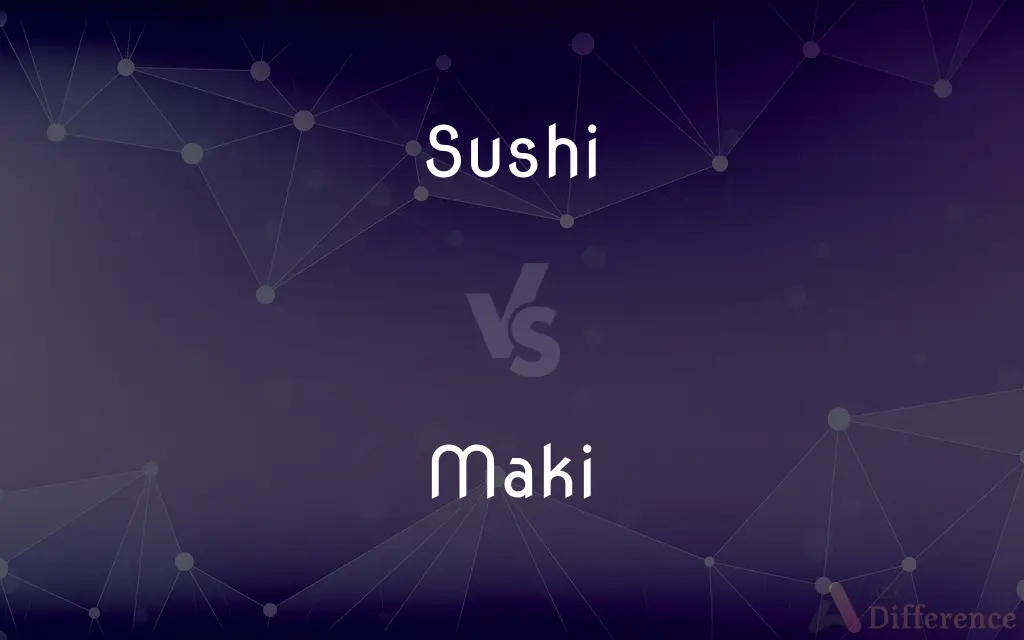Sushi vs. Maki — What's the Difference?
By Tayyaba Rehman — Updated on September 21, 2023
Sushi refers to any dish with vinegared rice; Maki is rolled sushi with rice wrapped in seaweed.

Difference Between Sushi and Maki
Table of Contents
ADVERTISEMENT
Key Differences
Sushi is a Japanese dish that primarily emphasizes vinegared rice, whether served with other ingredients or alone. Maki, on the other hand, specifically involves rolling sushi ingredients with rice and wrapping them in nori (seaweed).
Sushi is a broad category that includes many variations, whereas Maki represents a subset of sushi preparations. Both Sushi and Maki celebrate the delicate balance of flavors and textures, but Maki always requires the rolling technique.
While sushi can be a simple presentation of rice and a topping, Maki guarantees a roll, often sliced into bite-sized pieces.
Comparison Chart
Definition
Any dish made with vinegared rice.
Sushi roll with rice wrapped in seaweed.
Presentation
Can be rolls, pressed, or toppings on rice.
Always in roll form.
ADVERTISEMENT
Seaweed (Nori) Use
Not always used.
Always used on the outside or inside.
Ingredients Location
Ingredients can be on top or mixed with rice.
Ingredients are typically in the center.
Varieties
Includes Nigiri, Sashimi (no rice), Temaki, etc.
Includes Hosomaki, Uramaki, Futomaki, etc.
Compare with Definitions
Sushi
Can be raw or cooked preparations.
Traditional Sushi often uses raw fish.
Maki
Can have seaweed on the inside (Uramaki) or outside.
Traditional Maki has seaweed on the outside, but I prefer it inside.
Sushi
Not always wrapped in seaweed.
I ordered Sushi that was just rice topped with tuna.
Maki
Always involves the rolling technique.
Making Maki requires a bamboo mat to achieve its shape.
Sushi
A Japanese dish featuring vinegared rice.
I had Sushi with fresh salmon on top for lunch.
Maki
A type of sushi rolled with rice and other ingredients inside seaweed.
I ordered a spicy tuna Maki for dinner.
Sushi
Represents a wide range of Japanese rice dishes.
From Nigiri to Temaki, all are types of Sushi.
Maki
Ingredients are usually in the center.
In the Maki roll, avocado and crab were nestled in the middle.
Sushi
Rice accompanied by various ingredients like fish or vegetables.
She loves Sushi with a variety of fillings.
Maki
A subset of sushi specifically in roll form.
Of all the Sushi dishes, Maki rolls are my favorite.
Sushi
Sushi (すし, 寿司, 鮨, pronounced [sɯɕiꜜ] or [sɯꜜɕi]) is a traditional Japanese dish of prepared vinegared rice (鮨飯, sushi-meshi), usually with some sugar and salt, accompanying a variety of ingredients (ネタ, neta), such as seafood, often raw, and vegetables. Styles of sushi and its presentation vary widely, but the one key ingredient is "sushi rice", also referred to as shari (しゃり), or sumeshi (酢飯).Sushi is traditionally made with medium-grain white rice, though it can be prepared with brown rice or short-grain rice.
Maki
Rolled sushi that typically consists of vinegar-flavored rice and cooked or raw fish, wrapped in a sheet of nori, and usually cut into bite-size pieces.
Sushi
Cold cooked rice dressed with vinegar that is shaped into pieces and topped with raw or cooked fish, or formed into a roll with fish, egg, or vegetables and often wrapped in seaweed.
Maki
A ring-tailed lemur.
Sushi
A Japanese dish made of small portions of sticky white rice flavored with vinegar, usually wrapped in seaweed and filled or topped with fish, vegetables or meat.
For the vegetarians, she served cucumber sushi.
Maki
Makizushi, a form of sushi that is rolled.
Sushi
(proscribed) Raw fish, especially as a Japanese dish.
Maki
A lemur. See Lemur.
Sushi
Rice (with raw fish) wrapped in seaweed
Common Curiosities
Is Maki always wrapped in seaweed?
Yes, Maki always involves seaweed, either on the inside or outside of the roll.
What is Sushi?
Sushi refers to any dish made with vinegared rice, sometimes accompanied by other ingredients.
Does Sushi always include fish?
No, Sushi can be made with a variety of ingredients including vegetables, eggs, and more.
Is all Sushi raw?
No, Sushi can be both raw or cooked.
What is Maki?
Maki is a type of sushi roll where ingredients are wrapped in rice and seaweed.
Is Maki a type of Sushi?
Yes, Maki is a subset of Sushi preparations.
Does Sushi always involve rice?
While traditional Sushi always involves rice, dishes like Sashimi don't but are often grouped with Sushi.
Can Sushi be vegetarian?
Yes, there are many vegetarian Sushi options.
Is the rice in Sushi and Maki the same?
Yes, both use short-grain rice seasoned with vinegar, sugar, and salt.
What differentiates Sushi from Maki?
While Sushi refers to any dish with vinegared rice, Maki is specifically a roll with rice and ingredients wrapped in seaweed.
Can Maki have more than one ingredient inside?
Absolutely, Maki can have multiple fillings.
Are there different types of Maki?
Yes, there are variations like Hosomaki (thin rolls), Uramaki (inside-out rolls), and Futomaki (thick rolls).
Can you eat Sushi and Maki without soy sauce?
Yes, they can be enjoyed without soy sauce, depending on personal preference.
Does Sushi originate from Japan?
Yes, Sushi has its origins in Japan.
How is Maki different from Temaki?
Maki is a rolled sushi cut into pieces, while Temaki is a hand-rolled cone-shaped sushi.
Share Your Discovery

Previous Comparison
Deoxyadenosine vs. Adenosine
Next Comparison
Versus vs. AgainstAuthor Spotlight
Written by
Tayyaba RehmanTayyaba Rehman is a distinguished writer, currently serving as a primary contributor to askdifference.com. As a researcher in semantics and etymology, Tayyaba's passion for the complexity of languages and their distinctions has found a perfect home on the platform. Tayyaba delves into the intricacies of language, distinguishing between commonly confused words and phrases, thereby providing clarity for readers worldwide.














































